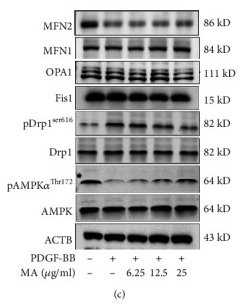SF3B1 Antibody - #AF7653
| 製品: | SF3B1 Antibody |
| カタログ: | AF7653 |
| タンパク質の説明: | Rabbit polyclonal antibody to SF3B1 |
| アプリケーション: | WB IF/ICC |
| Cited expt.: | WB |
| 反応性: | Human, Mouse, Rat |
| 予測: | Pig, Zebrafish, Bovine, Horse, Sheep, Rabbit, Dog, Chicken, Xenopus |
| 分子量: | 145kDa; 146kD(Calculated). |
| ユニプロット: | O75533 |
| RRID: | AB_2844017 |
製品説明
*The optimal dilutions should be determined by the end user. For optimal experimental results, antibody reuse is not recommended.
*Tips:
WB: For western blot detection of denatured protein samples. IHC: For immunohistochemical detection of paraffin sections (IHC-p) or frozen sections (IHC-f) of tissue samples. IF/ICC: For immunofluorescence detection of cell samples. ELISA(peptide): For ELISA detection of antigenic peptide.
引用形式: Affinity Biosciences Cat# AF7653, RRID:AB_2844017.
折りたたみ/展開
Hsh 155; MDS; Pre mRNA processing 10; Pre mRNA splicing factor SF3b 155 kDa subunit; PRP 10; PRP10; PRPF 10; PRPF10; SAP 155; SAP155; SF3B 1; SF3b155; Spliceosome associated protein 155; Splicing factor 3b subunit 1 155kDa; Splicing factor 3B subunit 1;
免疫原
A synthesized peptide derived from human SF3B1, corresponding to a region within N-terminal amino acids.
- O75533 SF3B1_HUMAN:
- Protein BLAST With
- NCBI/
- ExPASy/
- Uniprot
MAKIAKTHEDIEAQIREIQGKKAALDEAQGVGLDSTGYYDQEIYGGSDSRFAGYVTSIAATELEDDDDDYSSSTSLLGQKKPGYHAPVALLNDIPQSTEQYDPFAEHRPPKIADREDEYKKHRRTMIISPERLDPFADGGKTPDPKMNARTYMDVMREQHLTKEEREIRQQLAEKAKAGELKVVNGAAASQPPSKRKRRWDQTADQTPGATPKKLSSWDQAETPGHTPSLRWDETPGRAKGSETPGATPGSKIWDPTPSHTPAGAATPGRGDTPGHATPGHGGATSSARKNRWDETPKTERDTPGHGSGWAETPRTDRGGDSIGETPTPGASKRKSRWDETPASQMGGSTPVLTPGKTPIGTPAMNMATPTPGHIMSMTPEQLQAWRWEREIDERNRPLSDEELDAMFPEGYKVLPPPAGYVPIRTPARKLTATPTPLGGMTGFHMQTEDRTMKSVNDQPSGNLPFLKPDDIQYFDKLLVDVDESTLSPEEQKERKIMKLLLKIKNGTPPMRKAALRQITDKAREFGAGPLFNQILPLLMSPTLEDQERHLLVKVIDRILYKLDDLVRPYVHKILVVIEPLLIDEDYYARVEGREIISNLAKAAGLATMISTMRPDIDNMDEYVRNTTARAFAVVASALGIPSLLPFLKAVCKSKKSWQARHTGIKIVQQIAILMGCAILPHLRSLVEIIEHGLVDEQQKVRTISALAIAALAEAATPYGIESFDSVLKPLWKGIRQHRGKGLAAFLKAIGYLIPLMDAEYANYYTREVMLILIREFQSPDEEMKKIVLKVVKQCCGTDGVEANYIKTEILPPFFKHFWQHRMALDRRNYRQLVDTTVELANKVGAAEIISRIVDDLKDEAEQYRKMVMETIEKIMGNLGAADIDHKLEEQLIDGILYAFQEQTTEDSVMLNGFGTVVNALGKRVKPYLPQICGTVLWRLNNKSAKVRQQAADLISRTAVVMKTCQEEKLMGHLGVVLYEYLGEEYPEVLGSILGALKAIVNVIGMHKMTPPIKDLLPRLTPILKNRHEKVQENCIDLVGRIADRGAEYVSAREWMRICFELLELLKAHKKAIRRATVNTFGYIAKAIGPHDVLATLLNNLKVQERQNRVCTTVAIAIVAETCSPFTVLPALMNEYRVPELNVQNGVLKSLSFLFEYIGEMGKDYIYAVTPLLEDALMDRDLVHRQTASAVVQHMSLGVYGFGCEDSLNHLLNYVWPNVFETSPHVIQAVMGALEGLRVAIGPCRMLQYCLQGLFHPARKVRDVYWKIYNSIYIGSQDALIAHYPRIYNDDKNTYIRYELDYIL
種類予測
Score>80(red) has high confidence and is suggested to be used for WB detection. *The prediction model is mainly based on the alignment of immunogen sequences, the results are for reference only, not as the basis of quality assurance.
High(score>80) Medium(80>score>50) Low(score<50) No confidence
研究背景
Involved in pre-mRNA splicing as a component of the splicing factor SF3B complex. SF3B complex is required for 'A' complex assembly formed by the stable binding of U2 snRNP to the branchpoint sequence (BPS) in pre-mRNA. Sequence independent binding of SF3A/SF3B complex upstream of the branch site is essential, it may anchor U2 snRNP to the pre-mRNA. Together with other U2 snRNP complex components may also play a role in the selective processing of microRNAs (miRNAs) from the long primary miRNA transcript, pri-miR-17-92 (By similarity). May also be involved in the assembly of the 'E' complex. Belongs also to the minor U12-dependent spliceosome, which is involved in the splicing of rare class of nuclear pre-mRNA intron.
Phosphorylated. Phosphorylation occurs concomitantly with the splicing catalytic steps. Phosphorylation on Thr-244, Thr-248 and Thr-313 by cyclin-dependent kinases promotes interaction with PPP1R8 during mitosis.
Citrullinated by PADI4.
Nucleus. Nucleus speckle.
Note: During mitosis, transiently dispersed from the nuclear speckles to the cytoplasm.
Belongs to the SF3B1 family.
研究領域
· Genetic Information Processing > Transcription > Spliceosome.
参考文献
Application: WB Species: Mouse Sample:
Restrictive clause
Affinity Biosciences tests all products strictly. Citations are provided as a resource for additional applications that have not been validated by Affinity Biosciences. Please choose the appropriate format for each application and consult Materials and Methods sections for additional details about the use of any product in these publications.
For Research Use Only.
Not for use in diagnostic or therapeutic procedures. Not for resale. Not for distribution without written consent. Affinity Biosciences will not be held responsible for patent infringement or other violations that may occur with the use of our products. Affinity Biosciences, Affinity Biosciences Logo and all other trademarks are the property of Affinity Biosciences LTD.



